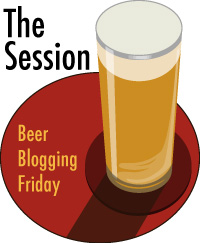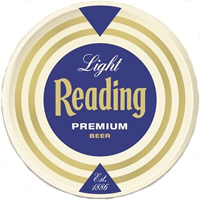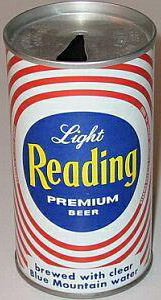![]()
March comes in like a lager for our 25th monthly Session, a.k.a. Beer Blogging Friday, thanks to John Duffy, a.k.a. The Beer Nut, whose theme this time around is “Love Lager,” by which he means the cheap stuff, the mass-produced swill, the … well, let’s let him tell us:
It’s the world’s most popular style of beer and can be found in abundance in almost every corner of the globe. For millions of people the word “beer” denotes a cold, fizzy, yellow drink — one which is rarely spoken of among those for whom beer is a hobby or, indeed, a way of life.
So for this Session, let’s get back to basics. I’m sure I’m not the only one whose early drinking career featured pale lager in abundance, so consider this a return to our roots as beer drinkers. Don’t even think about cheating the system: leave your doppelbocks and schwarzbiers out of this one: I want pilsners, light lagers, helleses and those ones that just say “beer” because, well, what else would it be?
I want to know what’s so great about them, and what’s awful. Are we talking just lawnmowers, barbecues and sun holidays here, or is there a time for some thoughtful considered sipping of a cold fizzy lager?

|
Well, I suppose there’s some truth to what he says. I assume like most people of my generation, at least, I did grow up on interchangeable light-bodied lagers, in my case mostly regional brands that are no longer with us from where I hail from, the southeastern area of Pennsylvania that I refer to as “Dutch Wonderland.” There’s no real area that’s been given that name, except in my mind. Dutch Wonderland is actually a C-rate amusement park in Lancaster. But to me, that seems the perfect appellation because it was a wonderful place to grow up and the Dutch refers not to the Netherlands, but to its German heritage. It’s Dutch like Pennsylvania Dutch, a corruption of Deutsch, meaning German. And I grew up near the heart of Amish Pennsylvania. In fact, my relatives emigrated there in the early 1700s from Bern, Switzerland, which is in the German-speaking part of Switzerland. They were Anabaptists and settled on a farm in what today is Bernville. My relatives were essentially Mennonites, which are like reformed Amish. Or perhaps more correctly, the Amish are conservative Mennonites who rejected certain technologies and, unlike most immigrants, managed to avoid assimilation. |
By the time I came along, the family farm was sold, and the relatives of my grandparents’ generation had scattered. I grew up just outside of Reading, and that’s “red-ding,” NOT “reed-ding” for all you Monopoly players who remember it was the first railroad on the board. My hometown, from age 5 up, was Shillington, a one-square mile plot housing around 6,000 people. Its most famous son was author John Updike, who recently passed away. It’s about a one and a quarter-hour drive northwest from Philadelphia.
|
All over Eastern Pennsylvania in the 1960s and 70s, there were quite a number of regional brands that were either still going, or which were still being brewed under license by someone bigger who’d acquired the brand name. Just off the top of my head, there was Carling, Fyfe & Drum, Ortlieb, Schaefer, Schmidt’s, Sunshine and Yuengling. Who knows how many names are lost due to the systematic killing off of my brain cells. But it was hometown favorite Reading Beer that I remember so clearly. Advertising for the brand was everywhere throughout town. Actually, it still is in many of the old corner bars that continue to dot the city. They had those concentric circles on the cans that really made them stand out. My memory, actually, is that the beer wasn’t very good. They went out of business in 1976, when I began my senior year of high school (though I think Schaefer continued brewing it in Fogelsville). At that age, my friends and I weren’t terribly picky about our beer. But because Reading Premium was fairly ubiquitous and pretty cheap, it was not unusual that that’s what we’d end up with. Even to my untrained palate and at an age when I’d drink whatever I could manage to get my hands on, I don’t remember the taste of Reading Premium all that fondly. |

|
I don’t recall great variation in the many different regional beers that were available at the time. We had our favorites, though I believe now they must have been all based on perceptions created by marketing and advertising. For us, it was about image. We all had relatives who had their particular brands they were more or less loyal to. My stepfather gravitated toward Carling Black Label, my Mom — when she drank at all — liked Sunshine, and I had an uncle who drank only Schmidt’s. Why? Beats me, I couldn’t really see the why they were loyal to their brands; they were virtually indistinguishable as far as I could tell.

|
I have great nostalgia for the brand, but almost entirely for their image, the cool graphics, the slogan: “Friendly Beer for Modern People,” and the fact that it was my hometown.
Given Anheuser-Busch’s rise to prominence, it’s curious to recall that when I was a youth, it was a brand that had almost no presence in my area. In fact, it was generally perceived, especially as I entered the teens as a new beer, as a brand with rebellious overtones because it was new to us and was definitely not our father’s beer. In fact, the marketing of that perception was so successful that I once wore a Budweiser t-shirt to church one Sunday, for which my Mother later went apoplectic when she learned of my immature act of rebellion. But in the end I suppose it was that sameness that made me so receptive to new beers when I left home and lived in New York City in the late 1970s. The only beer that tasted any different than almost every beer available when I was a teenager was Genesee Cream Ale, and even then it was a favorite simply because it was different; a little less bitter, a little more sweet, a least in fond memory. So when I encountered newly imported beers like Bass, Guinness and Pilsner Urquell in jazz clubs throughout New York City, they were a revelation. And that’s what led me down the beer-soaked path I’m on now. |
The commodification of beer, like so many other foods and beverages, is ultimately a doomed idea. It may be, and in this case has been, successful for a long time. But eventually people will rebel against that kind of conformity. It happens in music, in fashion, in everything. No matter how popular, diversity will eventually win out over bland sameness. That’s in part what fueled the microbrewery revolution; a desire to drink beers that didn’t all taste the same. The same thing happened in bread when people tired of Wonder bread; in cheese when Kraft individual slices ceased to be the height of sophistication; and when fast food hamburgers were no longer the highest purpose put to cows.
But in an apparent contradiction, nostalgia is also a potent draw for beer these days. It speaks volumes about just how effective and successful marketing and adverting has been in creating positive associations and connections to brands. Witness the recent success of Pabst, and the re-introductions of Rheingold, Narragansatt, Primo and Schllitz, to name just a few. Happily, Reading Premium also made a comeback in 2007, brewed once again in Reading by a small brewer, Legacy Brewing. (And by coincidence, the Berks County Historical Society is currently having an exhibition called Beer and Pretzels, about Reading’s rich history of brewing and pretzel-making.)
I had a chance to try the beer last year while I was in Philadelphia for the first Philly Beer Week, which as it happens begins again today for the second years’ festivities. And it tasted pretty good, I must say. Certainly, it’s better than when I was a teenager. Like virtually all of the re-introductions, it’s formula has been updated to modern sensibilities, thank goodness. It no longer had the harsh aftertaste I associated with it as a kid. Now it’s just a simple, well-made but inoffensive beer. It’s not complex or rich with big flavors. But it has as much “drinkability” as any other light-flavored lager macro brand, probably a little bit more, since it’s all-malt, at least.

So what’s the takeaway in all this meandering? It was light lagers that I first loved, like almost everybody, when I had an immature, undeveloped palate. Their inoffensive character wasn’t necessarily what initially drew them to me, since that’s all that was available at the time, unlike today. (Which I guess is my curmudgeonly way of saying young people are better off today, beer-wise, then when I was first 21. We had to walk to the bar, uphill, both ways.) But eventually, that sameness made me want more, and once I found that beer could be so much more, I never looked back, except through the eyes of nostalgia. Not everyone makes that leap, sadly, as evidenced by 95% of Americans still drinking mostly swill, well-made swill perhaps, but still largely unchanged in the fifty years I’ve walked the planet. That’s the power of the big company’s access to market, their juggernaut of marketing and advertising, and most people’s apathy in choosing what to eat and drink.
There are certainly more flavorful lagers than the macro-ones masquerading as pilsners, but they’re as rare as ales, at least in terms of market share. Bland lagers are the worldwide favorite it would seem, and more’s the pity. It’s hard to love that fact, no matter how much nostalgia I can muster.

It really is amazing that 95% of people are still drinking the big 5…which is trending toward even more conglomeration. People need to realize that because of their already huge market share, some of these light lager companies are gobbling up smaller ones. I’m hoping the rebellion against status quo you are talking about happens soon. Just by way of example, Pilsner Urquell (the world’s first Pilsner) is owned by the S.A.B group. You can guess what I call them. Of course, they tore out their wooden vessels and replaced them with stainless steel. Point being that when these bland lager making companies by out others, they “blandify” their products as well. This is where some of the rebellion and protectionism of tradition could stand to come in.
As far as the lack of taste that many Americans are stuck in (and getting them out of it), I wrote about that not too long ago, too http://thankheavenforbeer.com/2009/03/02/beer-vangelism-101-methods-for-converting-the-heathen-beer-drinker/.
Bye the way, nice thoughts (as always).
Diggin’ the nostalgia. I have a half dozen Reading cans in my garage along with about 1,000 other cans. I think I saw some in your office, too. It’s funny how those cans can trigger nostalgic thoughts about where I obtained the can (often trading with friends or at a “canvention”). I would love to see more posts – once or twice a year — about can collecting.